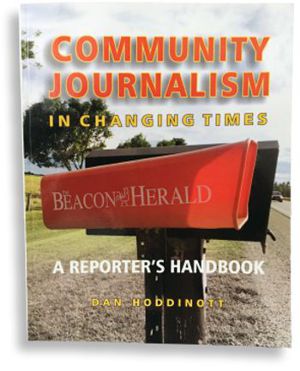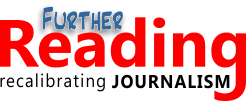Waving the banner
It's not easy being seen, but fading from view is a worse fate
By DAN HODDINOTT
Everyone remembers the hometown newspaper. It’s locked in adult memory banks right next to grade school crushes, July ice cream, varsity achievement, Santa Claus parades, teenage curiosity and first jobs. The local daily is what brought glimpses of the outside world to town, and lined up local newsmakers and events right alongside them. Faithful clippings from the rural weekly still populate some mothers’ scrapbooks. For some folks, favourite memories might include the harried photographer showing up at school, doing his level best to cram an unwieldy bunch from the sports team or science project into a single frame. For others, the allure of grand front pages staring back from street corner news boxes is a welcome recollection. Or it might be that old brick building itself, where idle kids — rounded up on a Wednesday evening — might earn a few bucks collating newspapers coughed out by clattering printing presses, amid the intoxicating odor of ink and greased metal.
INVISIBLY VISIBLE FOR THE MOST PART, seldom might the local newspaper have reason to command your full attention back in the halcyon days of youth. But it found a place in what would become your sacred-by-virtue-of-becoming-irretrievable yesterday anyway. Your hometown would not have been the same place without it, so integrated was it in the life of a community and such a fundamental part of the landscape. Even paper routes, viewed from the perspective of dutiful carrier and expectant recipient alike, were as much a fact of life as any butcher, baker or candlestick maker.
Piece by piece, however, the hometown newspaper is becoming visibly invisible in Canadian towns and cities. Front pages seldom stare back from street corner boxes anymore; they’ve been removed, boxes and all. Racks are disappearing from drug store and corner store entranceways faster than Arctic ice retreating from southern poison, and stacks of papers can scarcely be found anymore staking their ground in once-familiar displays.
It’s not only the passive display of printed newspapers receding from public view. The change ripples across the entire fabric of hometown life.
Reporters in jalopies don’t sputter into school parking lots or Saturday morning Scout events with the same frequency, what with demands of release forms and other panic-driven security regulations now cluttering up once-seamless statements of understanding between public caretakers and the local scribe/shutterbug. At home, work-worn fathers in easy chairs don’t cluck the same on Wednesday nights (and rustle the pages of the arms-wide open paper for punctuation) the way they used to, in response to some item liked or disliked. Fewer aunts, too, are pausing to look up from the social pages and mutter “Imagine that” when provoked by a tidbit about someone they know; nowadays they are apt to not look up at all, but keep swiping on their tablet even as they mutter. Hanging out around town, brash and excitable student athletes, verified and affirmed by local sports coverage, don’t leave the paper — sports-section-up — on the table at Tim Hortons the way pride was once expressed; these days they can assert supremacy, and settle heated arguments too, in rowdy cars in the drive-thru — via a phone whipped from a shirt pocket, point of contention reached by a well-practiced thumb sequence and then a five-inch illuminated screen rammed in the driver’s face, even as he’s leaning out to place the order. In some cases, the once-mysterious brick building on the edge of town has morphed into some other, less enchanting, place of business.
Less visible to the naked eye
The newspaper is not driven out of sight, as some might believe, by the tidal wave of digital media itself. That’s only part of the story. We’re also shunted out of sight by a shift in social intercourse, and by decisions we make in distribution models for our print edition, by our newsrooms' calculated coverage rhythms and by business decisions made — often with survival for the day, not building for the morrow, as primary motivator.
Even when we’re there we’re less visible to the naked eye.
No one is arguing the validity of the struggle as the industry transitions from reliance on declining print-edition revenues to a largely elusive model capable of generating sustainable revenue from digital sources. But with so many moving parts in play we can’t afford to have any that undermine engine efficiency. Every department in the business has to be doing its level best to remind the people that we’re here, we’re strong and we will remain their best news and advertising solution going forward.
In Community Journalism In Changing Times: A Reporter’s Handbook I cover this from an editorial department perspective, and propose strategies to help avoid the inevitable outcome should it be left unchecked. Fading from public consciousness is not a good thing, for any aspect of our business. Editorially, being recognized as the paper of record is essential to our being considered in all of the official decision making that has an impact on our ability to function; it is equally so for the revenue-generating departments and for the boardroom too. Therefore, seizing every opportunity to fly the flag — making sure our brand is seen around town — is important now more than ever.
Maintaining our presence takes a conscious effort, for any vanishing from public importance we experience is taking place unconsciously as much as it is through deliberate action.
It is imperative that we remain important in the mind of our audience.
No matter what department you operate in, it is good to ask yourself this question: What are we doing to ensure we are regarded as important in the community?


